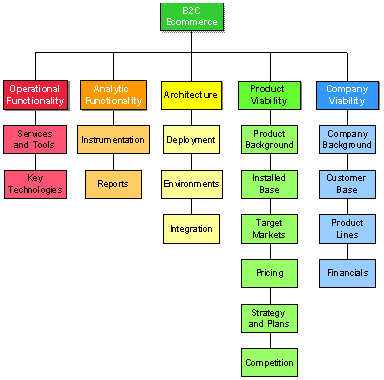B2C Ecommerce Evaluation Framework
How to Evaluate Software that Supports Consumers’ Shopping, Buying, and Account Management
Many of your customers prefer doing business with you online. They go to your Web sites to find, learn about, and buy your products that address their needs. They also set up and manage accounts with you. When those customers are consumers, we call these activities B2C ecommerce. B2C software products and services help you implement and deploy Web sites that support these consumer customer activities. In this report, we present our framework for evaluating B2C ecommerce software. Use the framework to reduce the time, cost, and risk for evaluating and selecting the B2C ecommerce software product that is best for your organization.
NETTING IT OUT
Many of your customers prefer doing business with you online. They go to your Web sites to learn about your products and services, to find products and/or services that address their needs, to configure and price the products and/or services that they’d like to buy, and to purchase those products and/or services. They also set up and manage accounts with you.
When those customers are consumers, we call these activities B2C (business to consumer) ecommerce. From the perspective of your business, your B2C ecommerce site can be a significant marketing and sales channel, driving significant revenue at lower cost of sales than assisted-service channels.
B2C ecommerce software provides self-service facilities that let organizations implement and deploy Web sites that support these consumer customer activities.
In this report, we present our framework for evaluating B2C ecommerce software. The framework has these six top-level evaluation criteria:
- Operational functionality
- Analytic functionality
- Architecture
- Product viability
- Company viability
Use the framework to reduce the time, cost, and risk for evaluating and selecting the B2C ecommerce software product that is best for your organization.
B2C Ecommerce Evaluation Framework

© 2008 Patricia Seybold Group, Inc.
Illustration 1. This illustration shows the evaluation criteria and sub-criteria of the PSGroup B2C Ecommerce Evaluation Framework.
B2C ECOMMERCE
A Framework for Evaluating Ecommerce Software
This report presents our B2C ecommerce evaluation framework. The framework is a set of criteria that you can use to help select the ecommerce software product or service that’s best for your organization. We’ll use the framework to evaluate and compare the leading ecommerce products and services, giving your selection process a jump start.
We based the criteria for the framework on our long and continuing ecommerce experience in three critical areas:
- First, in our work with your customers, speaking with them to understand their issues, requirements, and visions in doing business with you and by encouraging them to communicate those issues, requirements, and visions with you.
- Second, in our work with organizations like yours, helping you become more customer-centric by helping you understand how your customers want to do business with you and then helping you redefine your policies, processes, and technologies to address those requirements.
- Third, in our work with ecommerce software suppliers, helping them understand the benefits of customer-centricity, encouraging them to view their market from their customers’ (your) perspective and to build systems to meet their customers’ requirements.
Like all of our evaluation frameworks, the B2C ecommerce evaluation framework can deliver significant benefits to you. It can reduce the time, reduce the cost, and reduce the risk in your process to select an ecommerce offering. We explain the key decision factors, focusing your efforts of criteria that differentiate competing offerings. Our framework-based product reviews identify the leading ecommerce products and services and deliver apples-to-apples evaluations and comparisons of them. Use these reports to get to a short list quickly.
We’ve been publishing evaluation frameworks since 1993. Back then, we’d written them for RDBMSs and client/server application development tools. The first version of a B2C evaluation framework dates back to 1998. Currently, you can use ?? of our evaluation frameworks to help evaluate and compare all the products and technologies that comprise your customer experience.
Framework Terms and Context
Let’s define the terms and the context of our B2C ecommerce evaluation framework.
- Ecommerce is the set of activities that customers perform on the Internet channel to learn about your products and services, to find products and/or services that address their needs, to configure and price the products and/or service s that they’d like to buy, and to purchase those products and/or services. Ecommerce also includes customers’ activities to set up and manage accounts with you.
- B2C ecommerce is ecommerce between business and consumers. Consumers are individual end-customers and their households who act as agents for themselves.
- B2C ecommerce software provides self-service facilities that let organizations implement and deploy Web sites that support these customer activities for consumers.
- The self-service facilities of ecommerce software comprise: 1) services and tools such as product comparisons or gift registries used by customers to perform ecommerce activities and 2) technologies such as Web content and product data that you customize and deploy to support to support these services and tools.
With these definitions in mind, let’s examine customers’ ecommerce activities and the self-service facilities of ecommerce software a little more closely.
CUSTOMERS’ B2C ECOMMERCE ACTIVITIES
Cross-Channel, Cross-Lifecycle Customer Experience
Your customers do business with you through all the channels that you support across all the activities of the lifecycle of your relationships with them. Your have self-service channels through which your systems support customer activities, and you have assisted-service channels through which your agents perform customer activities on behalf of your customers. Customers’ activities occur within a lifecycle that starts with their first interaction and ends with their retirement (or desertion). We organize those activities into lifecycle phases, and we name those phases explore, select, purchase, install, use, and manage.
Shopping for and Buying Products and/or Services Online
Your B2C ecommerce system is a component of your cross-channel, cross-lifecycle customer experience. These systems support self-service channels for customers’ activities within the explore, select, purchase, and manage lifecycle phases—your customers’ online shopping and buying activities. In Table A, we list these activities within each lifecycle phase in a little more detail....
B2C Ecommerce Activities
Please download the PDF to see the table.
Table A. In this table, we list B2C ecommerce activities within their lifecycle phases.
Sign in to download the full article
0 comments
Be the first one to comment.



